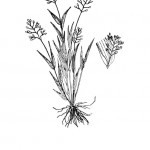Scribner Dichanthelium , Scribner's Rosette Grass
Dichanthelium oligosanthes var. scribnerianum
Poaceae
Description
The stems of this small bunchgrass are usually smooth but can be slightly hairy. If so, the hairs grow parallel to the stem. The base is flat, showing a rosette of wide but short basal leaves in winter. Leaf blades are erect, 2 to 5 inches or 5 to 13 cm long, and nearly as wide. They are spear-shaped with fine, short hairs on the underside. The sheath has distinct parallel veins and is covered with fine, stiff hairs growing from small bulbs or papilla. The inflorescence is an open panicle with wiry but flexible branches. Primary inflorescence bloom time occurs from May to July, and secondary inflorescence bloom time occurs from June to September. The seed head is open, irregularly shaped, with spikelets on the ends of the seed branches and sub-branches. The seed coat is lined and may have a few scattered hairs. Upper glumes are veined and have a prominent orange or purplish spot at the base. Scribner Dichanthelium is a perennial, cool-season, native standing from 10 to 25 inches or 25.4 to 63.5 cm tall. Fair grazing for both livestock and wildlife.Habitat
This species can be found on open prairies, disturbed areas, or dry open woodlands where there are sandy or clayey soils. Its distribution ranges from Canada to Northern Mexico.Images
Plant Characteristics
Seed Type: Non-Encapsulated
Duration: Perennial
Stem Texture: Hairy
Growth Habit: Bunch grass, Grasses
Season: Cool
Distribution
 : 01 - Pineywoods, 02 - Gulf Prairies and Marshes, 03 - Post Oak Savannah, 04 - Blackland Prairies, 05 - Cross Timbers and Prairies, 07 - Edwards Plateau, 09 - High Plains
: 01 - Pineywoods, 02 - Gulf Prairies and Marshes, 03 - Post Oak Savannah, 04 - Blackland Prairies, 05 - Cross Timbers and Prairies, 07 - Edwards Plateau, 09 - High Plains
Distributions
Distribution refers to the ecological region in Texas that a plant has been found. You can also view a clickable map.
Book: Know Your Grasses (B-182)
Collection: Grasses


